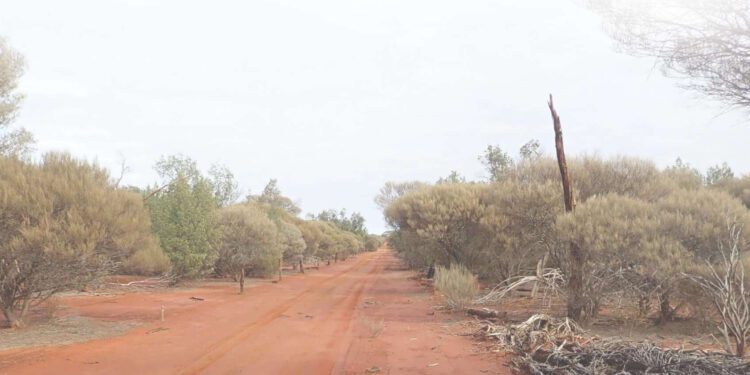Six g/t Au Intersected Over At Least 300m
Miramar Resources Limited (ASX:M2R) has received multiple high-grade gold results from the Marylebone target within the company’s 80%-owned Gidji JV Project in the Eastern Goldfields region of Western Australia.
The new results from 1m resplits of the Phase 3 aircore drilling programme confirm the potential for Paddington and/or Panglo-style gold mineralisation at Marylebone.
Significant results include:
- GJAC306 – 1m @ 6.92g/t Au (48-49m)
- GJAC315 – 3m @ 2.61g/t Au (45-48m) including 1m @ 6.16g/t Au
- GJAC318 – 1m @ 3.54g/t Au (53-54m)
- GJAC325 – 4m @ 1.11g/t Au (46-50m) including 1m @ 3.55g/t Au
- GJAC328 – 1m @ 5.15g/t Au (52-53m)
The Marylebone target comprises two parallel zones of coherent supergene gold mineralisation along the contact between mafic and ultramafic rocks in similar stratigraphic positions to the 4Moz Paddington deposit, the 125koz Panglo deposit and other gold deposits along the Boorara Shear Zone.
GJAC306 and GJAC315, which both intersected +6g/t Au, are located approximately 300m apart along the “Paddington contact”, whilst the +3g/t Au intersections in GJAC318 and GJAC325 are located 200m apart and appear equivalent to the position of the Panglo deposit.
The northwest trending contacts are crosscut by later north-south trending faults, similar to Paddington.
The footprint of the Marylebone target now extends for over 1.9km and remains open to the northwest on the recently granted Gidji JV tenements.
Executibve Chairman, Allan Kelly, said the new results continued to reinforce the significance of the Marylebone target and the potential for a large new gold discovery close to Kalgoorlie.
“The new results include the most significant gold numbers received from Gidji to date and have also helped us identify the structures with the closest similarities to the Paddington and Panglo gold deposits along strike to the northwest,” Mr Kelly said
“Our aircore drilling is still relatively wide spaced, given the stripped weathering profile present beneath the transported material, and the average hole depth to date at Marylebone is only about 60m, whereas the primary mineralisation at Paddington reportedly starts at about 70m, just below the supergene enriched gold zone.
“We are very excited about the opportunity for a new discovery at Marylebone and also look forward to testing the newly granted tenements along strike to the northwest, where the same geology seen at Marylebone continues for at least another 1.4km, but is virtually undrilled,” he added.
Section 6080N is the northernmost complete section of aircore drilling at Marylebone to date. The drilling on this section traverses the sequence of Black Flag sediments, alternating ultramafic and mafic rocks, and at least one thin horizon of black shale.
Coherent supergene gold anomalism >0.1g/t Au at the contact between transported material and weathered Archean basement extends over 600m laterally on this section.
The highest-grade results on this section, in GJAC315 and GJAC318, are both located proximal to mafic units in positions apparently equivalent to the Paddington and Panglo deposits. The gold mineralisation in GJAC318 is coincident with 6.28g/t Ag indicating proximity to a bedrock source.
The current drill spacing is roughly 50m across strike whereas the Paddington bedrock footprint is reportedly only 30-40m across. Assays for GJAC431 and 432, completed as infill holes, are pending.
There is no historic drilling north of this section for over 360m, where two aircore holes spaced 100m apart intersected 4m @ 0.4g/t Au and 4m @ 0.34g/t Au.
Section 5820N is located approximately 260m south of Section 6080N and intersected a similar sequence of rocks but with only one potential mafic intrusive unit identified to date.
Coherent supergene gold anomalism >0.1g/t Au at the contact between transported material and weathered Archean basement also extends over 600m laterally on this section with gaps in the drill coverage due to a pipeline and the presence of a hard silcrete layer intersected in GJAC308 and GJAC309.
GJAC306 ended in a weathered mafic unit in the interpreted Paddington position but did not reach “blade refusal” and is considered an ineffective test. Despite this, GJAC306 intersected 1m @ 6.9g/t Au at 48- 49m, towards the base of the transported material, and ended in >0.1g/t Au at 61m with coincident anomalous Ag and Sb indicating proximity to a bedrock source.
GJAC325 to GJAC328 intersected the interpreted Panglo position, although no mafic rocks were identified in these holes. GJAC325 intersected supergene gold (4m @ 1.11g/t Au) towards the base of the transported material above lower grade basement gold anomalism, whilst the gold anomalism intersected in GJAC326 to 328 (including 1m @ 5.15g/t Au) is hosted in the weathered basement and associated with anomalous Ag, Mo and Sb.
The current drill spacing is also roughly 50m across strike, apart from the where the pipeline crosses the section, and with assays pending for GJAC428 and 429.
For further information please visit: https://www.miramarresources.com.au/












